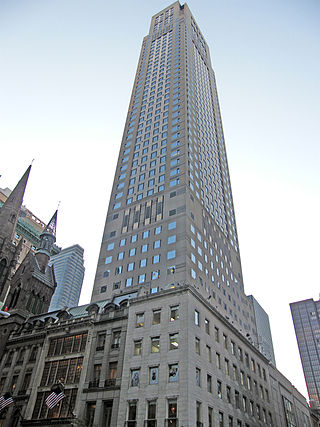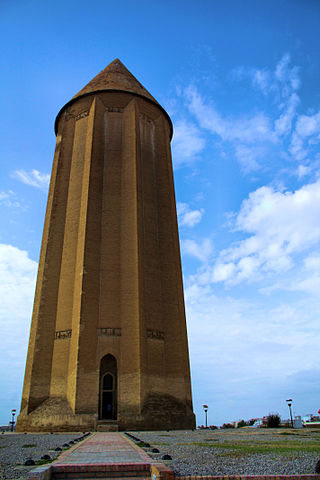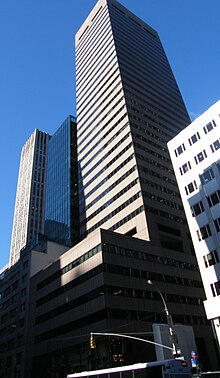
Reza Shah Pahlavi was an Iranian military officer, politician, and first shah of the House of Pahlavi of the Imperial State of Iran and father of the last shah of Iran. He reigned from 15 December 1925 until he was forced to abdicate by the Anglo-Soviet invasion of Iran on 16 September 1941. A modernizer, Reza Shah clashed with the Shia clergy, but also introduced many social, economic, and political reforms during his reign, ultimately laying the foundation of the modern Iranian state. Therefore, he is regarded by many as the founder of modern Iran.

The Milad Tower, also known as the Tehran Tower, is a multi-purpose tower in Tehran, Iran. It is the sixth-tallest tower and the world's first telecommunication tower in terms of the usage area of the top structure and the tallest tower in Iran and the 24th-tallest freestanding structure in the world. The construction of this tower took about 11 years and 7 months

Reza Pahlavi, Crown Prince of Iran is the oldest son of Mohammad Reza Pahlavi, the last Shah of Iran, and his wife Farah Diba. Before the Islamic Revolution in 1979, he was the crown prince and the last heir apparent to the throne of the Imperial State of Iran. Today, Pahlavi resides in Great Falls, Virginia.

Bank Melli Iran is the first national and commercial retail bank of Iran. It is considered as the largest Iranian company in terms of annual income with a revenue of 364 657 billion Rials in 2016. It is the largest bank in the Islamic world and in the Middle East. By the end of 2016, BMI had a net asset of $76.6 billion and a vast network of 3.328 banking branches; so it is known as the largest Iranian bank based on the amount of assets. The brand of BMI was recognized as one of the 100 top Iranian brands in 10th National Iranian Heroes Championship in 2013. The National Bank has 3328 active branches inside, 14 active branches and 4 sub-stations abroad and it has 180 booths. The first managing director of BMI was Kurt Lindenblatt from Germany, the first foreign branch of BMI was opened in Hamburg, Germany in 1948.
Islam entered Iran with the Muslim conquest (637–651) and led to the end of the Sasanian Empire and the eventual decline of the Zoroastrian religion in Iran (Persia). Since its establishment after the 7th-century conquest, Islam has remained the state religion of Iran except for during a short period after the Mongol invasions and subsequent establishment of the Ilkhanate in the 13th century. Following the Muslim conquest, there was a slow but steady movement of the population toward Islam, despite notable resistance, with nobility and city-dwellers being the first to convert, and the peasantry and the dehqans, or land-owning magnates slower to do so. By the 10th century, the majority of Persians had become Muslims.

Iranian architecture or Persian architecture is the architecture of Iran and parts of the rest of West Asia, the Caucasus and Central Asia. Its history dates back to at least 5,000 BC with characteristic examples distributed over a vast area from Turkey and Iraq to Uzbekistan and Tajikistan, and from the Caucasus to Zanzibar. Persian buildings vary greatly in scale and function, from vernacular architecture to monumental complexes. In addition to historic gates, palaces, and mosques, the rapid growth of cities such as the capital Tehran has brought about a wave of demolition and new construction.

Valiasr Street, formerly known as the Pahlavi Street, is a tree-lined street in Tehran, dividing the metropolis into western and eastern parts which were built in 1922 to 1927 respectively, considering the end of asphalt plan it ended in 1933. It is considered one of Tehran's main thoroughfares and commercial centers. It is also the longest street in the Middle East, and was reported as one of the longest in the world by former BBC journalist Rageh Omaar during the television documentary Welcome to Tehran.

Goharshad Mosque is a grand congregational mosque built during the Timurid period in Mashhad, Razavi Khorasan Province, Iran, which now serves as one of the prayer halls within the Imam Reza shrine complex.

Ali Qapu Palace or the Grand Ali Qapu is an imperial palace in Isfahan, Iran. It is located on the western side of the Naqsh-e Jahan Square, opposite to Sheikh Lotfollah Mosque, and had been originally designed as a vast portal entrance to the grand palace which stretched from the Naqsh-e Jahan Square to the Chahar Baq Boulevard. The palace served as the official residence of Persian Emperors of the Safavid dynasty. UNESCO inscribed the Palace and the Square as a World Heritage Site due to its cultural and historical importance. The palace is forty-eight meters high and there are six floors, each accessible by a difficult spiral staircase. In the sixth floor, Music Hall, deep circular niches are found in the walls, having not only aesthetic value, but also acoustic. Ali Qapu is regarded as the best example of Safavid architecture and a symbol of Iran's Islamic heritage.

Cultural Foundation of Refah was an elementary school for girls in Tehran, Iran. It gained historical significance in the 1979 Iranian Revolution when it was the temporary headquarters of the revolutionists led by Ruhollah Khomeini. It was also used for the Islamic Revolutionary Court and the execution of officials of the second Pahlavi Regime on its rooftop before being transformed into what is being currently used as, a cultural and educational institution.

712 Fifth Avenue is a 650-foot-tall (200 m) skyscraper at 56th Street and Fifth Avenue in the Midtown Manhattan neighborhood of New York City. Constructed from 1987 to 1990, it was designed by SLCE Architects and Kohn Pedersen Fox Associates. The skyscraper's base includes the Coty Building at 714 Fifth Avenue and the Rizzoli Bookstore building at 712 Fifth Avenue, both of which are New York City designated landmarks.

Mohammad Reza Pahlavi, widely known in the West as Mohammad Reza Shah, was the last Shah (King) of the Imperial State of Iran from 1941 until his overthrow in the Iranian Revolution in 1979. Owing to his recognition and status as Iran's final monarch, he is usually known simply as the Shah. Mohammad Reza Shah took the title Shahanshah on 26 October 1967 and held several other titles, including that of Aryamehr and Bozorg Arteshtaran ("Commander-in-Chief"). He was the second and last monarch of the House of Pahlavi to rule within Iran. His dream of what he referred to as a "Great Civilization" in Iran led to a rapid industrial and military modernization, as well as economic and social reforms.

650 Fifth Avenue is a 36-story 150 m (490 ft) building on the edge of Rockefeller Center on 52nd Street in New York City.

The Mostazafan Foundation of Islamic Revolution formerly Bonyad-e Mostazafan va Janbazan is a charitable bonyad, or foundation, in the Islamic Republic of Iran, the second-largest commercial enterprise in Iran behind the state-owned National Iranian Oil Company and biggest holding company in the Middle East. The foundation used to be directly run by Khomeini.

Corruption is a serious problem in Iran, being widespread, mostly in the government. Reformists and conservatives alike – routinely criticize corruption in the government.

The Al-Hadi School of Accelerative Learning (AHS) is an Islamic primary and secondary school in Southwest Houston, Texas. The school is founded by Nasser Biria and is located on the premises of the Islamic Education Center of Greater Houston (IEC) of Houston, which also houses one of the largest mosques in Houston. According to Faheem Kazimi, the chairperson of the IEC, it is a Houston-area school that runs on tuition fees that comes from the students ranging to $5000. The school is near Westheimer Road.

Propaganda in Iran originates from the Iranian government and "private" entities, which are usually state controlled.

Gonbad-e Qabus or Gonbad-e Qabus Tower is a monument in Gonbad-e Qabus, Iran, and a UNESCO World Heritage Site since 2012. It marks the grave of Ziyarid ruler Qabus, and was built during his lifetime in 1006/7. It is a cylindrical tomb tower that reaches c. 61 metres and can be seen from some 30 kilometres away. The eponymous city is named after the monument.

Hassan Alavikia was an Iranian general and businessman in the Pahlavi-era. Along with Teymur Bakhtiar and Hassan Pakravan, he was a co-founder of the SAVAK.

As of 2012, the city of Houston has the largest Muslim population in Texas and the largest Muslim population in the Southern United States. That year, Kate Shellnut of the Houston Chronicle wrote that "Some estimate that Muslims make up 1.2 percent of the city's population." As of 2012 the estimated population of Muslims in Houston was around 63,000. As of today, there are over 209 mosques and storefront religious centers, with the largest being the Al-Noor Mosque of the Islamic Society of Greater Houston (ISGH).



















